Southern Border Region (California): Difference between revisions
SoCal L.A. (talk | contribs) No edit summary |
if no reference added I will delete it next month |
||
| Line 5: | Line 5: | ||
[[Image:Oceansidepier.jpg|thumb|300px|right|[[Oceanside Pier]] at sunset]] |
[[Image:Oceansidepier.jpg|thumb|300px|right|[[Oceanside Pier]] at sunset]] |
||
[[Image:Glamis Presidents 263.jpg|thumb|300px|right|Holiday Weekend Traffic at [[Glamis Sand Dunes]]]] |
[[Image:Glamis Presidents 263.jpg|thumb|300px|right|Holiday Weekend Traffic at [[Glamis Sand Dunes]]]] |
||
'''Southern Border''', or '''San Diego-Imperial''', is defined by the State of California as the region that consists of California's border counties with [[Mexico]], [[San Diego County]] and [[Imperial County]]. Southern Border is also part of [[Southern California]] but exclude the five other Southern California counties which form [[Greater Los Angeles]]. The area encompasses the [[San Diego metropolitan area]] and the [[El Centro metropolitan area]]. SD Metro has 3,026,135 people while Imperial has 163,972 people. Southern Border is a term used to distinguish the region from the Greater Los Angeles area and a term used by the U.S. [[State of California]] to define the largest, in terms of diversity, economic region of the state.<ref>[http://search.ca.gov/search?q=cache:AtbaXur_WaEJ:www.labor.ca.gov/panel/pdf/CESP_Regions_100606.pdf&proxystylesheet=xfix&output=xml_no_dtd&client=xfix] |
'''Southern Border''', or '''San Diego-Imperial'''{{Citation needed|date=February 2010}]], is defined by the State of California as the region that consists of California's border counties with [[Mexico]], [[San Diego County]] and [[Imperial County]]. Southern Border is also part of [[Southern California]] but exclude the five other Southern California counties which form [[Greater Los Angeles]]. The area encompasses the [[San Diego metropolitan area]] and the [[El Centro metropolitan area]]. SD Metro has 3,026,135 people while Imperial has 163,972 people. Southern Border is a term used to distinguish the region from the Greater Los Angeles area and a term used by the U.S. [[State of California]] to define the largest, in terms of diversity, economic region of the state.<ref>[http://search.ca.gov/search?q=cache:AtbaXur_WaEJ:www.labor.ca.gov/panel/pdf/CESP_Regions_100606.pdf&proxystylesheet=xfix&output=xml_no_dtd&client=xfix] |
||
Economics</ref> |
Economics</ref> |
||
Revision as of 00:39, 20 February 2010
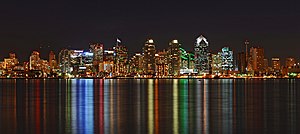


Southern Border, or San Diego-Imperial{{Citation needed|date=February 2010}]], is defined by the State of California as the region that consists of California's border counties with Mexico, San Diego County and Imperial County. Southern Border is also part of Southern California but exclude the five other Southern California counties which form Greater Los Angeles. The area encompasses the San Diego metropolitan area and the El Centro metropolitan area. SD Metro has 3,026,135 people while Imperial has 163,972 people. Southern Border is a term used to distinguish the region from the Greater Los Angeles area and a term used by the U.S. State of California to define the largest, in terms of diversity, economic region of the state.[1]
To the west of Southern Border lies the Pacific Ocean and to the east lies the California-Arizona state line. To the south the international border of the U.S. and Mexico as well as the international state borders of California and Baja California. To the north the border with the counties of Orange and Riverside.
Significance

In its boundaries is a world city, the City of San Diego, which is classified as a Gamma- world city. The city is re-owned for its resorts, amusement parks, wildlife parks and zoos as well many museums and beaches. With a population of 1,336,865, San Diego is the second most populous city in California, and the eighth most populous in the United States.
Southern Border also has in its boundaries the San Diego Bay, a natural harbor considered by some one of the best on the North American west coast. The bay is flanked by the San Diego International Airport, the busiest single runway airport in the world and the Port of San Diego, one of the busiest on the American west coast.[2] The U.S. Bureau of Transportation Statistics ranked the Port of San Diego as one of America's top 30 U.S. container ship ports bringing in nearly 3,300,000 metric tons (3,250,000 LT; 3,640,000 ST) of cargo per year. Together with the National City Marine Terminal, the Port of San Diego is the primary port of entry for Honda, Acura, Isuzu, Volkswagen, Nissan, Mitsubishi Fuso, and Hino Motors into America.
Southern Border is also home to a large home grown surf and skateboard culture hosting many local surfing events as well as the occasional international. As well as boarding off-roading on ATV's in Imperial Valley is another popular sporting event. The Imperial Valley Sand Dune Recreation area draws hundreds of thousands of off-road enthusiasts on good weekends.

Many popular museums, such as the San Diego Museum of Art, the San Diego Natural History Museum, the San Diego Museum of Man, and the Museum of Photographic Arts are located in Balboa Park. The Museum of Contemporary Art San Diego (MCASD) is located in an ocean front building in La Jolla and has a branch located at the Santa Fe Depot downtown. The Columbia district downtown is home to historic ship exhibits belonging to the San Diego Maritime Museum, headlined by the Star of India, as well as the unrelated San Diego Aircraft Carrier Museum featuring the USS Midway aircraft carrier.Tourism has affected the city's culture, as San Diego houses many tourist attractions, such as SeaWorld San Diego, Belmont amusement park, San Diego Zoo, and the nearby San Diego Wild Animal Park and Legoland California. San Diego's Spanish influence can be seen in the many historic sites across the city, such as the Spanish missions and Balboa Park. Cuisine in San Diego is diverse, and includes European-American, Mexican-American, and Asian-American cuisine. Annual events in San Diego include Comic-Con, San Diego/Del Mar Fair, and Street Scene Music Festival.
Hundreds of movies and a dozen TV shows have been filmed in San Diego, a tradition going back as far as 1898.
Regions
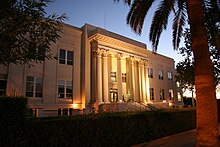
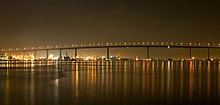


Cities
South Border is anchored in the west by San Diego and in the east by El Centro.
The coastal city of San Diego is the county seat of San Diego CountyTemplate:GR as well as the economic and cultural center of the San Diego metropolitan area considered congruent with the county. Money Magazine rated it the fifth best place to live in 2006 and according to Forbes the city ranks as the fifth wealthiest in the United States.[3][4] San Diego's biggest industries are manufacturing, military, as well as tourism. The economy of the city is composed largely of many sciences (biotechnology/biosciences & computer sciences) as well as electronics manufacturing, defense-related manufacturing, financial and business services, ship-repair, ship-construction, software development, telecommunications, wireless research, agriculture and tourism. The city is also host to the University of California, San Diego, located in the coastal community of La Jolla. San Diego can also be applauded for being host to one of the largest naval fleets in the world, as well as having become the largest concentration of Naval facilities in the world.
The desert city of El Centro is Southern California's promising new major commercial and industrial center for Imperial Valley, being the center of shipping exports as well as being home to retail, transportation, wholesale, and agricultural industries.[5] The area is also host to two international border crossings nearby for commercial and noncommercial vehicles located on the border with Mexicali, Mexico.[6] The city is 50 feet below sea level and the largest city in the nation below sea level. Plans involving the restoration of the Salton Sea, such as creating a sea-level canal connecting to the Gulf of California, bring hope that the region could serve as an inland port for Southern California which would also serve as a recreational and environmental asset following the course of it's length for humans and wildlife in both the United States and Mexico.
Major cities (over 100,000 inhabitants)

Population figures for California cities are 2008 State of California estimates[7]
- San Diego - 1,336,865
- Chula Vista - 231,305
- Oceanside - 178,806
- Escondido - 143,389
- Carlsbad - 103,811
Other cities with over 40,000 inhabitants

- El Cajon - 94,869
- Vista - 89,857
- San Marcos - 83,149
- Encinitas - 58,014
- La Mesa - 54,749
- Santee - 54,709
- National City - 54,260
- Poway - 48,044
- El Centro - 43,316
Cities with under 40,000 inhabitants
- Imperial Beach - 29,992
- Calexico - 27,109
- Lemon Grove - 24,918
- Coronado - 24,100
- Brawley - 22,052
- Solana Beach - 12,979
- Imperial - 11,754
- Calipatria - 7,289
Geographic Regions
Geographic Features

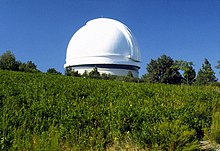
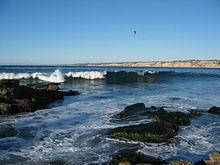
Southern Border is divided into two regions: San Diego and Imperial. San Diego's coastal side has a Mediterranean climate and semi arid the farther you move away from the coast however the region is pocketed with many micro-climates. Once you cross the coastal mountains the climate dramatically changes to desert as it enters the Imperial Valley. The only vegetation in this desert is that of agriculture. However the desert is filled with many hidden oases.
- Alamo River (Imperial County, Mexicali Municipality)
- Colorado River (San Bernardino, Riverside & Imperial Counties, Baja California & Sonora)
- Cuyamaca Mountains (San Diego County)
- Imperial Valley (Imperial County)
- In-Ko-Pah Mountains (San Diego County)
- Jacumba Mountains (San Diego County)
- La Jolla Cove (San Diego County)
- La Jolla Shores (San Diego County)
- Laguna Mountains (San Diego County)
- Low Desert (Imperial, Riverside & San Bernardino Counties)
- Mission Bay (San Diego County)
- New River (Imperial County, Mexicali Municipality)
- Palomar Mountain (San Diego County)
- Point Loma (San Diego County)
- Salton Sea (Imperial & Riverside Counties)
- San Diego Bay (San Diego County)
- San Diego River (San Diego County)
- San Luis Rey River (San Diego County)
- Santa Margarita River (Riverside, Orange & San Diego Counties)
- Sweetwater River (San Diego County)
- Sonoran Desert (San Diego County, Arizona, Mexicali Municipality)
- Sweetwater River (San Diego County)
- Tijuana River (San Diego County)
Tourism
Resorts
Hotel del Coronado
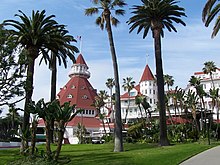
Coronado is home to the famous Hotel del Coronado, built in 1888 and long considered one of the world's top resorts.[8] It is listed as a National Historic Landmark and appeared in films such as Some Like It Hot and The Stunt Man. It was the setting of the Dashboard Confessional song Stolen. The historic hotel has had many notable American guests, including Charles Lindbergh, Thomas Edison, Babe Ruth, Jack Dempsey, Willie Mays, Magic Johnson, and Muhammad Ali. [citation needed] Many presidents have also visited, including William Howard Taft, Franklin D. Roosevelt, Lyndon Johnson, Richard Nixon, Gerald Ford, Jimmy Carter, Ronald Reagan, Bill Clinton, and George H.W. Bush.
Museums
Balboa Park
Balboa Park is a 1,200 acre (4.9 km²) urban cultural park in San Diego, California, United States named after the Spanish explorer Vasco Núñez de Balboa. Many of the trees here were planted by the famous American gardener Kate Sessions. Placed in reserve in 1835, it is one of the oldest sites in the United States dedicated to public recreational usage. Besides open areas and natural vegetation, it contains a variety of cultural attractions including museums, theaters, gardens, shops and restaurants as well as the San Diego Zoo. Balboa Park was declared a National Historic Landmark in 1977. The park is managed and maintained by the City of San Diego Parks and Recreation Department.
Along this boulevard are many of the park's museums and cultural attractions, including the San Diego Museum of Man, the San Diego Museum of Art, the Museum of Photographic Arts, the San Diego Art Institute the San Diego Model Railroad Museum, the Natural History Museum, the San Diego Historical Society, the Reuben H. Fleet Science Center, and the Timken Museum of Art where admission is always free. There are a number of gardens located in the park. These include Alcazar Garden, Botanical Building, Cactus Garden, Casa del Rey Moro Garden, Inez Grant Parker Memorial Rose Garden, Japanese Friendship Garden, Marston House Garden, Palm Canyon and Zoro Garden.
Wildlife Parks & Zoos
SeaWorld San Diego
SeaWorld San Diego is a theme park located in San Diego, California. The park is owned by SeaWorld Parks & Entertainment, a division of The Blackstone Group. SeaWorld's main attraction is its orcas, several of which are housed in 7 million gallon habitats that are each known as Shamu Stadium. Shamu was the name of the first orca brought to SeaWorld San Diego in the 1960s. "Shamu" is now used as a stage name for adult Orcas in performances at SeaWorld parks. The Orcas all have individual names.
San Diego Wild Animal Park
The San Diego Zoo's Wild Animal Park is a zoo in the San Pasqual Valley area of San Diego, California. It is one of the largest tourist attractions in the city and Southern California. The Park houses a large array of wild and endangered animals including species from the continents of Africa, Asia, Europe, North and South America, and Australia. The park is in a semi-arid environment and one of its most notable features is the Journey into Africa tram which explores the expansive African exhibits. These free-range enclosures house such animals as cheetahs, antelopes, lions, giraffes, okapis, elephants, zebras, Przewalski's horses, rhinos, and bonobos. The park is also noted for its California condor breeding program, the most successful such program in the country.
Military
San Diego is the headquarters of the U.S. Navy's Eleventh Naval District and is the Navy's principal location for West Coast and Pacific Ocean operations.[9] Naval Base San Diego, California is principal home to the Pacific Fleet (although the headquarters is located in Pearl Harbor). NAS North Island is located on the north side of Coronado, and is home to Headquarters for Naval Air Forces and Naval Air Force Pacific, the bulk of the Pacific Fleet's helicopter squadrons, and part of the West Coast aircraft carrier fleet.
The Naval Special Warfare Center is the primary training center for SEALs, and is also located on Coronado. The area contains five major naval bases and the U.S. Marines base Camp Pendleton. Marine Corps Base Camp Pendleton is the major West Coast base of the United States Marine Corps and serves as its prime amphibious training base.[10] It is located on the Southern California coast, bordered by Oceanside to the south, San Clemente to the north, and Fallbrook to the east. There are numerous airforce and military bases throughout all of Southern Border.
Earthquakes
Each year the southern California area has about 10,000 earthquakes. Nearly all of them are so small that they are not felt. Only several hundred are greater than magnitude 3.0, and only about 15-20 are greater than magnitude 4.0.[11]
The Great Southern California ShakeOut
The Great Southern California ShakeOut is based on a potential magnitude 7.8 earthquake on the southern San Andreas Fault— approximately 5,000 times larger than the magnitude 5.4 earthquake that shook southern California on July 29, 2008.[12] While the San Andreas Fault has experienced massive earthquakes in 1857 at its central section and in 1906 at its northern segment (the 1906 San Francisco earthquake), the southern section of the fault has not seen a similar rupture in at least 300 years.
If such an earthquake were to occur, it would result in substantial damage to Palm Springs and a number of other cities in San Bernardino, Riverside and Imperial counties in California, and Mexicali municipality in Baja California. Such an event would be felt throughout much of Southern California, including densely populated areas of metropolitan Los Angeles, Orange County, San Diego and Tijuana, Baja California.
Transportation

Roads

 Interstate 5
Interstate 5 Interstate 8
Interstate 8 Interstate 15
Interstate 15 Interstate 805
Interstate 805 State Route 7
State Route 7 State Route 15
State Route 15 State Route 52
State Route 52 State Route 54
State Route 54 State Route 56
State Route 56 State Route 67
State Route 67 State Route 76
State Route 76 State Route 78
State Route 78 State Route 79
State Route 79 State Route 86
State Route 86 State Route 94
State Route 94 State Route 98
State Route 98 State Route 111
State Route 111 State Route 115
State Route 115 State Route 125
State Route 125 State Route 163
State Route 163 State Route 188
State Route 188 State Route 905
State Route 905
Airports
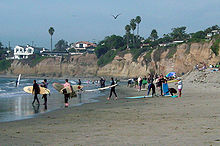
| Airport | IATA code | ICAO code | City |
|---|---|---|---|
| San Diego International Airport | SAN | KSAN | San Diego |
| Imperial County Airport | IPL | KIPL | Imperial |
| Calexico International Airport | CXL | KCXL | Calexico |
| Holtville Airport | L04 | none | Holtville |
| Montgomery Field | MYF | KMYF | San Diego |
Other airports include
- McClellan-Palomar Airport, (CLD or CRQ) a.k.a. Palomar Airport, Carlsbad Airport
- Gillespie Field, (SEE) located in El Cajon
- Agua Caliente Airport
- Borrego Valley Airport
- Fallbrook Airport
- Jacumba Airport
- Lake Wohlford (private, tiny)
- Oceanside Municipal Airport
- Ocotillo Airport
- Pauma Valley (private)
- Ramona Airport, (RNM)
- Brown Field, (SDM) (former East Field, NAAS Otay Mesa, and NAAS Brown Field)
- Carlsbad Airport
Railroad
Sports teams
| Team | Sport | League | Venue |
|---|---|---|---|
| San Diego Padres | Baseball | Major League Baseball | PETCO Park |
| San Diego Chargers | Football | National Football League | Qualcomm Stadium |
See also
{{{inline}}}
References
- ^ [1] Economics
- '^ San Diego International Airport
- ^ "Best Places to Live 2006". MONEY Magazine. 2006. Retrieved November 29, 2009.
{{cite news}}: Italic or bold markup not allowed in:|publisher=(help) - ^ Clemence, Sara (October 28, 2005). "Richest Cities In The U.S." Forbes. Retrieved April 22, 2009.
{{cite news}}: Italic or bold markup not allowed in:|publisher=(help) - ^ Source City of El Centro
- ^ Source City of El Centro
- ^ "Population Estimates for Cities, Counties and the State with Annual Percent Change". California Department of Finance.
- ^ Source HotelDel
- ^ citydata.com
- ^ Estes, Kenneth W. (1999). The Marine Officer's Guide - Sixth Edition. Annapolis, Maryland: Naval Institute Press. p. 176. ISBN 1-55750-567-5.
- ^ "USGS facts". data from Southern California Earthquake Center. Retrieved 2009-03-18.
- ^ "The ShakeOut Earthquake Scenario". data from Southern California Earthquake Center. Retrieved 2009-03-18.


